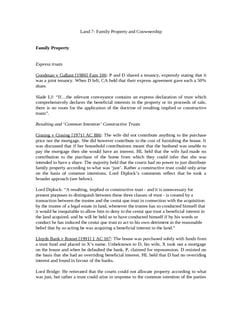Elliston v Reacher [1908] Ch 374
Judgement for the case Elliston v Reacher
Table Of Contents
The court was asked whether a building scheme had been established.
Held
It had. The court set out the factors which must be shown to establish a building scheme on an estate; Both plaintiff and defendant's titles must derive from the same vendor who must have laid out a definitive scheme for development before the sales, and intended to impose mutually enforceable restrictions between the plot purchasers.
Every buyer must have known of the intended scheme and the restrictions and of the intended mutual enforceability.
Also the fact that the benefit of the covenants in a scheme may also attach to property which is situated outside the area of the scheme is not necessarily fatal to the requirement of reciprocity and mutuality between the properties within the scheme.
Parker LJ
It must be proved:
(1) that both the plaintiffs and defendants derive title under a common vendor;
(2) that previously to selling the lands, to which the plaintiffs and defendants are respectively entitled, the vendor laid out his estate, or a defined portion thereof (including the lands purchased by the plaintiffs and defendants respectively), for sale in lots subject to restrictions intended to be imposed on all the lots, and which, though varying in details as to particular lots, are consistent and consistent only with some general scheme of development;
(3) that these restrictions were intended by the common vendor to be and were for the benefit of all the lots intended to be sold, whether or not they were also intended to be and were for the benefit of other land retained by the vendor; and
(4) that both the plaintiffs and the defendants, or their predecessors in title, purchased their lots from the common vendor upon the footing that the restrictions subject to which the purchases were made were to enure for the benefit of the other lots included in the general scheme whether or not they were also to enure for the benefit of other lands retained by the vendors.
If these four points be established, I think that the plaintiffs would in equity be entitled to enforce the restrictive covenants entered into by the defendants or their predecessors with the common vendor irrespective of the dates of the respective purchases.
I may observe, with reference to the third point, that the vendor's object in imposing the restrictions must in general be gathered from all the circumstances of the case, including in particular the nature of the restrictions.
If a general observance of the restrictions is in fact calculated to enhance the values of the several lots offered for sale, it is an easy inference that the vendor intended the restrictions to be for the benefit of all the lots, even though he might retain other land the value of which might be similarly enhanced, for a vendor may naturally be expected to aim at obtaining the highest possible price for his land.
Further, if the first three points be established, the fourth point may readily be inferred, provided the purchasers have notice of the facts involved in the three first points; but if the purchaser purchases in ignorance of any material part of those facts, it would be difficult, if not impossible, to establish the fourth point.
RELATED CASES
For Further Study on Elliston v Reacher
Need instant answers? Our AI exam tutor is here to help.
Ask questions 🙋 Get answers 📔 It's simple 👁️👄👁️
Our AI is educated by the highest scoring students across all subjects and schools. Join hundreds of your peers today.
Get StartedSimilar Cases
Related Product Samples
These product samples contain the same concepts we cover in this case.
| Land Law | Easements Notes (48 pages) |

 Since 2010, Oxbridge Notes has been a trusted education marketplace, supplying high-quality materials from top achievers at universities like Oxford, Cambridge, LSE, Harvard, and Yale.
Since 2010, Oxbridge Notes has been a trusted education marketplace, supplying high-quality materials from top achievers at universities like Oxford, Cambridge, LSE, Harvard, and Yale.